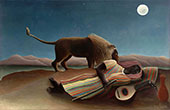The Sleeping Gypsy 1897 By Henri Rousseau
The Sleeping Gypsy by Henri Rousseau is one of the most famous examples of primitive artwork. This oil on canvas painting reveals a mysterious atmosphere and imaginative subject matter which has captivated art lovers ever since its inception.
When did Henri Rousseau paint The Sleeping Gypsy?
Painted in 1897, The Sleeping Gypsy is a dream-like depiction of a woman and a lion illuminated by the light of the moon.
Rousseau first exhibited his oil painting at the Paris Salon des Indépendants that same year. As a proud resident of Laval (a municipality in western France), Rousseau hoped the town’s mayor would purchase the work.
Sadly, the painting didn’t appeal to mayoral tastes; a Parisian charcoal merchant purchased the work.
In 1924, the painting changed hands again. This time, the famed art dealer Daniel-Henry Kahnweiler bought the artwork. Kahnweiler later sold the art to Alfred H. Barr, working on behalf of the New York Museum of Modern Art.
What is the meaning behind Rousseau's Jungle Painting?
The Sleeping Gypsy, like much of Henri Rousseau's art, is shrouded in mystery.
Despite this, there are certain clues to its meaning.
For instance, Rousseau described the woman as a mandolin player. In addition, he identified the vessel beside her as containing drinking water. Rousseau further specified the woman lay in a deep sleep, overcome by extreme fatigue.
Amidst this unusual subject matter, the artist described how a lion chances upon the scene. However, while the ferocious animal picks up the woman’s scent, it does not attack. Rousseau described the painting as having a “moonlight effect, very poetic.”
Rousseau joined much of the French elite in his fascination with “wandering gypsies.” Referred to as “bohémiens,” Romany people were discussed and fetishized for their position on the fringes of French society.
Common contemporary perceptions linked Romany people with Egypt and Bohemia, perhaps explaining the arid landscape of Rousseau’s dream-like world and the woman’s dark-skinned appearance.
In addition, the painting suggests a desire for a pre-industrial past. At this time, France (and Paris in particular) witnessed massive changes due to the Industrial Revolution. In contrast to the world of capitalist logic, the Romantic and Primitive painters aimed to reconnect with our emotional selves.
Of course, danger lurks with any attempt to create this deeper level of connection. The lion’s unnerving eye gazes directly toward the viewer, challenging our bravery. The woman’s razor-sharp teeth further evoke a sense that this mysterious world is teetering on the edge of dream and nightmare.
How did Rousseau create his oil painting?
Henri Rousseau jungle paintings use a gradual building-up of flat planes of color. Rousseau’s Sleeping Gypsy relies on simple geometric forms contrasted with the mysterious, exotic subject matter.
Largely self-taught, the artist worked as a tax collector by day. However, due to his unusual techniques and subject matter, Rousseau was repeatedly denied entry to the highly traditional Académie Française.
Despite (or perhaps because of) this rejection, however, Rousseau was later lauded by the twentieth-century French avant-garde artists. As a result, along with Henri Rousseau’s The Dream (1910), The Sleeping Gypsy has become an icon of modern art.
Intriguingly, Rousseau never left Paris. Consequently, the desert landscape is from observation within Parisian botanic gardens. Rousseau frequently visited the Jardin des Plantes, which contained an astounding array of flora and fauna captured during French colonization.
Rousseau may have also viewed colonized individuals “displayed” at the 1889 Paris World’s Fair. Famous French illustrations and adventure stories also depicted images of French imperial conquest, all sources which Rousseau may have used in the creation of his famous painting The Sleeping Gypsy.
Discover the amazing world of Henri Rousseau's jungle paintings by visiting our extensive catalog of famous art reproductions in our Animal Artwork collection.
We offer a 100% money back guarantee or replacement service. If for any reason you are dissatisfied with your painting please contact us within 7 days of receipt, advising the reason you are unhappy and we will provide you with all the information you need for its return or replacement.
We ship free to anywhere in the world via FedEx or DHL expedited service with online tracking.
Your painting will be shipped rolled in strong plastic tubing, ready for stretching and/or framing locally. This is the conventional method of transporting hand-painted oil on canvas. Learn more about how your painting is shipped.
We are able to offer a framing service intercontinental U.S. Please contact us if you would like a quotation. Alternatively, should you prefer, we can recommend a framer in your area.
Notes About Your Painting
Please note that replica oil paintings are finished with an additional 10cm (4") of extra canvas on all sides, allowing ample surplus canvas for stretching and framing.
Recently Viewed:
Cannot Find What You Are Looking For?
Reproduction Gallery Information
Customer Service
(Send Us A Message)
Tel: (503) 937 2010
Fax: (503) 937 2011







